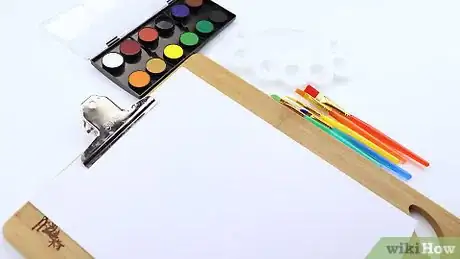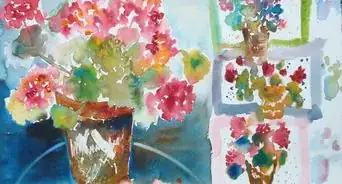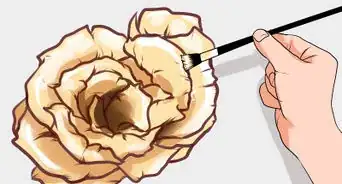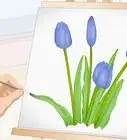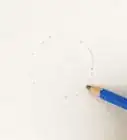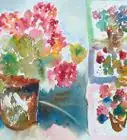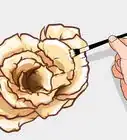This article was co-authored by Jeanine Hattas Wilson. Jeanine Hattas Wilson is a Professional Painter and the President of Hattas Public Murals, Inc. With nearly 20 years of experience, Jeanine specializes in creating, overseeing, designing, and painting murals. Jeanine holds a BA in Advertising from Marquette University and a Studio Painting Minor from The Milwaukee Institute of Art & Design. She has studied at The Atelier Artien in Paris, France, Los Angeles Academy of Figurative Art, and under renowned artists such as Robert Liberace, Michael Siegel, and William Cochran. To date, Hattas Public Murals has painted nearly 5,000 commissioned works of art in homes and commercial and public spaces.
This article has been viewed 53,839 times.
A painting of flowers is a great gift and beautiful work of art. It's colorful and shows happiness and joy. Here you'll learn how to capture the picture of bright flowers in a painting.
Steps
-
1Gather the necessary supplies and find a flat, clean surface to work on. For reference, see the supply list near the bottom of this article.
-
2On a clean, white piece of paper, paint the green grass at the bottom. Use short, light strokes and make the pieces of grass go in different directions so it looks more realistic. Use regular green and add light green if you'd like to get the 'highlighted' look or dark green strokes for shadow and texture.Advertisement
-
3Make curved lines of medium thickness. Using a darker shade of green, paint curved lines of medium thickness among the grass. These lines will become your flowers' stems, so make as many lines as you want flowers. The height of the lines should be quite a bit taller than the grass.
- The thickness of the stem should be slightly thicker than the grass.
- Add leaves or thorns to the stems to make the flowers look more realistic.
-
4Create the center of the flower. Using whatever color you prefer, create a circle/oval about 1/2 inch above the tip of the flower stem. Leave room above the tip of the stem so that you can add petals.
-
5Add petals. What color do you want your flower/s to be? You can mix colors, or just paint single color petals. Pick out the colors you want to use or mix colors to create new ones. Then, determine what shape you want the petals of the flowers to be. You may want to sketch the shape before you pain them. Connect the petals to the center of the flower. Connect the tip of the stem to somewhere in between two petals beneath the center.
- Paint the petals in their base color and use other shades to create highlights, shadows, and details.
-
6Outline the petals with black or white paint if you'd like. Do it if you want your flowers to look a bit cartoon-like, but skip this step if you want them to look more realistic.
Things You'll Need
- A few clean, white pieces of paper (colored works too)
- Small, medium, and large paint brushes
- Rainbow colors of paint
- Artist's pallet
- Oil pastels (optional)
About This Article
To paint flowers, first paint a few vertical curved lines using green paint for the stems. Then, paint a small circle or oval above each curved line using a different color. These will be the centers of your flowers. Next, choose a different color and paint the petals coming off of the centers. Use wide, soft brush strokes to give your petals a soft and even texture. Build your colors up and add more color to the stems or centers of the flowers if you paint over them. If you want to go for a more realistic look, add white highlights around edges of petals on one side. Next, use some darker colors on the opposite side of each petal to give them a more dynamic look. Add any leaves to the stems if you’d like and finish your painting by adding any smaller details you wish to add.
